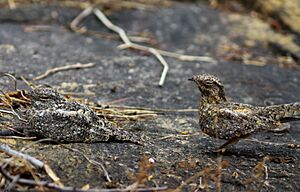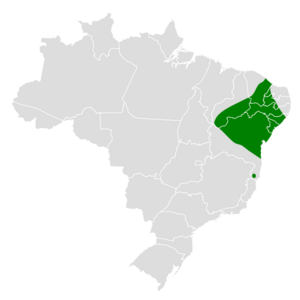Pygmy nightjar facts for kids
Quick facts for kids Pygmy nightjar |
|
|---|---|
 |
|
| Conservation status | |
| Scientific classification | |
| Genus: |
Nyctipolus
|
| Species: |
hirundinaceus
|
 |
|
| Synonyms | |
|
Caprimulgus hirundinaceus |
|
The pygmy nightjar (Nyctipolus hirundinaceus) is a small bird. It belongs to the nightjar family. This bird lives only in Brazil. It is known for being active from dusk until dawn.
Contents
What Kind of Bird Is It?
Scientists group living things into families. The pygmy nightjar is part of the nightjar family, called Caprimulgidae. It used to be in a different group, Caprimulgus. But DNA tests showed it needed its own group. Its closest relative is the blackish nightjar.
There are three types of pygmy nightjars. These are called subspecies. They are N. n. nigrescens, N. n. cearae, and N. n. veilliardi.
What Does the Pygmy Nightjar Look Like?
This bird is about 16 to 20 centimeters (6 to 8 inches) long. One male bird weighed about 32 grams (1.1 ounces).
Male pygmy nightjars have brown feathers on their backs. These feathers have small gray-white and cinnamon spots. Their tail is brown with lighter stripes. Some tail feathers have white tips. They have a light, buff-colored stripe on their throat. Their chin and throat are white with brown stripes.
The upper part of their chest has a wide, buff-cinnamon band. This band has brown spots. The lower chest is brown with light spots and stripes. Their belly and sides are buff-colored with brown stripes.
Female pygmy nightjars look much like the males. But their colors are a bit lighter. They also do not have the white tips on their tail feathers.
The N. n. cearae subspecies is lighter than the main type. It has a more reddish-brown belly. Its tail has more white. The N. n. veilliardi subspecies is darker than the main type.
Where Do Pygmy Nightjars Live?
The main type of pygmy nightjar lives in northeastern Brazil. You can find it in the states of Piauí, Bahia, and Alagoas.
The N. n. cearae subspecies also lives in northeastern Brazil. It is found from northern Ceará down to the very north of Bahia.
The N. n. veilliardi subspecies lives in southeastern Minas Gerais. It also lives in west-central Espírito Santo in eastern Brazil.
This bird likes dry places. It lives in scrublands and forests where trees lose their leaves. In the caatinga region, it prefers rocky or stony areas. In the Atlantic Forest region, it is often found near rocky outcrops.
How Do Pygmy Nightjars Behave?
Pygmy nightjars usually live alone. They only come together when it's time to have babies. During the day, they rest on the open ground.
How Pygmy Nightjars Find Food
These birds are active from when the sun sets until it rises. They hunt in open areas. They fly up from the ground to catch insects. Then they fly back to the same spot. We don't know much about their diet. But we know they eat insects.
Reproduction
Pygmy nightjars have their babies during the rainy season. This is usually between November and May. The female lays just one egg. She lays it right on the bare ground.
The female bird takes care of the nest during the day. The male bird takes over at night. Both parents try to distract anything that might be a danger to their egg.
What Sounds Do Pygmy Nightjars Make?
The pygmy nightjar's song is a short whistle. It sounds like "wheeo" or "wheo". This song often starts with a quick series of 3 or 4 "wha" notes. For example, it might sound like "wha wha wah wheeo." When they are alarmed, they make a "prrip" sound.
What Is Their Status?
The IUCN is a group that checks on animals. They say the pygmy nightjar is of "Least Concern." This means it is not in immediate danger of disappearing. However, we don't know how many of these birds there are. Their numbers are thought to be going down.
Their home in the caatinga region is changing. More people are moving there. Also, more land is being used for farming. This affects where the birds can live.


